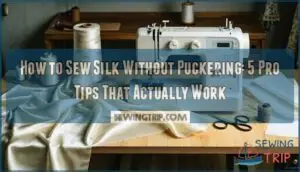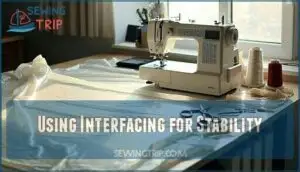This site is supported by our readers. We may earn a commission, at no cost to you, if you purchase through links.

First, switch to a sharp 70/10 or 80/12 universal needle – dull needles create holes that cause fabric distortion. Second, loosen your machine tension by one or two settings from normal cotton tension.
Third, reduce your stitch length to 2.0-2.5mm for better control. Fourth, stabilize the fabric by placing tissue paper underneath while sewing, then tear it away afterward.
Table Of Contents
Key Takeaways
- Use the right needle and tension settings – Switch to a sharp 70/10 or 80/12 needle and loosen your machine tension by 1-2 settings to prevent fabric distortion and thread pulling.
- Shorten your stitch length and slow down – Set the stitch length to 2.0-2.5mm and sew at a moderate, consistent speed to maintain better control over the slippery fabric.
- Stabilize the fabric during sewing – Place tissue paper underneath the silk while stitching, then tear it away afterward to prevent shifting and bunching.
- Prepare your silk properly before cutting – Pre-wash to prevent shrinkage, use sharp cutting tools with pattern weights, and choose medium-weight silks like crepe de Chine for easier handling.
Sewing Silk Basics
You’ll discover that working with silk doesn’t have to be intimidating once you master a few key techniques.
The secret lies in understanding your fabric’s unique properties and setting up your workspace properly before you even thread your machine.
Success lies in preparation—understanding silk’s nature transforms intimidating fabric into manageable luxury.
Choosing The Right Silk Fabric
Your fabric choice makes or breaks your silk sewing project.
Medium-weight silks like crepe de Chine offer stability and forgiveness for beginners learning silk sewing techniques.
Avoid lightweight charmeuse initially—it’s slippery and shows every imperfection.
Choose printed fabrics over solids; patterns camouflage minor mistakes while you master working with silk.
Tightly woven silk types resist distortion and prevent puckering better than loose weaves.
To achieve professional results, understanding silk fabric basics is essential for selecting the right material for your project, which requires a good understanding of silk sewing techniques and the importance of fabric choice.
Preparing Silk for Sewing
Once you’ve selected your silk fabric, proper preparation sets the stage for smooth sewing.
Pre washing silk prevents shrinkage and watermarks later – test a small piece first using gentle baby soap and cold water. Hang to dry completely away from direct sunlight.
Before cutting, align selvages and use pattern weights with sharp tools for precise silk cutting methods. To achieve professional results, utilizing proper silk sewing kits is essential for handling delicate fabrics.
Essential Sewing Tools for Silk
Before mastering silk’s slippery nature, you’ll need the right arsenal.
Sharp needles like Microtex needles (60/8 or 70/10) prevent snags, while silk pins won’t leave permanent holes.
Quality silk cutting tools guarantee clean edges, and fabric stabilizers tame unruly fabric.
Don’t forget silk thread options and fresh sewing machine oil for smooth operation, including the use of fabric stabilizers.
Sew Silk Without Puckering
Now that you’ve got your silk fabric ready and tools organized, it’s time to tackle the main challenge: preventing those dreaded puckers that can ruin your beautiful project.
Puckering happens when your fabric gets stretched or pulled during sewing, creating unwanted wrinkles that won’t press out.
Silk’s slippery fibers rebel under tension, leaving permanent wrinkles that mock your careful stitching efforts.
The secret lies in controlling fabric movement and machine settings.
Start with proper Fabric Grain Management by keeping your silk flat and supported while feeding it through your machine.
Don’t rush – let the feed dogs do their work without pulling or pushing the fabric.
Your Sewing Machine Maintenance plays a huge role too, so make certain everything’s running smoothly before you begin.
Here are five proven puckering prevention techniques:
- Use tissue paper under delicate silk to prevent shifting
- Reduce presser foot pressure to minimize fabric distortion
- Choose silk sewing tips like slightly loosening your top tension
- Practice sewing silk smoothly with consistent, moderate speed
- Test Silk Thread Options on scraps before starting your project
To achieve professional results, understanding silk sewing basics is essential for managing silk’s unique characteristics.
Stabilizing Silk Fabric
Stabilizing silk fabric is the key to preventing those frustrating puckers that can ruin your beautiful garment.
You’ll need the right combination of interfacing, needles, and thread to keep this slippery fabric behaving properly under your machine.
Using Interfacing for Stability
Adding interfacing to silk fabric prevents puckering by providing essential support during sewing.
Choose lightweight, fusible interfacing that won’t overwhelm silk’s natural drape. Nonwoven fabric stabilizers work best since they resist shifting and remain invisible on sheer silk.
Cut your interfacing slightly smaller than the seam allowance to reduce bulk. Test different interfacing types on scraps first—this simple step saves you from costly mistakes later.
Understanding proper interfacing tips is essential for achieving a professional finish in silk sewing projects.
Choosing The Right Needle for Silk
Choosing the right needle transforms your silk sewing experience from frustrating to flawless.
You’ll need Microtex or sharp needles in sizes 60/8 for delicate silks or 70/10 for heavier weights.
Skip universals—they’ll snag your precious fabric and create puckering nightmares.
Fresh, high-quality needles pierce cleanly through silk threads without dragging or distorting the weave.
Using the right silk sewing techniques is essential for achieving professional results.
Selecting The Best Thread for Silk
Your needle choice sets the foundation, but thread selection makes or breaks your silk project.
Cotton thread works best for silk sewing – it’s strong yet gentle on delicate fibers. High-quality polyester offers similar results.
Here’s your thread selection roadmap:
- Cotton thread – Top choice for durability and silk compatibility
- High-quality polyester – Excellent alternative with consistent performance
- Avoid silk thread – Too slippery for structural seams
- Match thread weight to fabric thickness for balanced stitching
Color matching prevents visible contrast lines that highlight imperfections. When working with silk, using the right silk sewing thread is vital for a professional finish.
Sewing Machine Settings
Your sewing machine settings make the difference between smooth silk seams and frustrating puckered messes.
Getting the right stitch length, presser foot, and tension settings transforms silk from a challenging fabric into one that’s actually enjoyable to work with.
Adjusting Stitch Length for Silk
Precision in silk sewing depends on mastering stitch length—your secret weapon against puckering nightmares.
Set your machine to 2.0-2.5mm for ideal silk stitch control and fabric tension.
Lower sewing speed prevents thread selection issues while proper needle calibration guarantees smooth seams.
| Silk Weight | Stitch Length | Speed Setting |
|---|---|---|
| Lightweight | 2.0mm | Slow |
| Medium-weight | 2.5mm | Medium |
Reorganizing your sewing approach with these tips will help you achieve professional-looking results with silk fabric.
Using The Right Presser Foot for Silk
Your presser foot makes all the difference between smooth silk sewing and frustrating puckering nightmares.
Switch to a Teflon or walking foot for effortless fabric glide techniques.
Here are three essential Silk Foot Options:
- Teflon foot – prevents sticking and reduces drag
- Walking foot – feeds fabric evenly through layers
- Roller foot – glides smoothly over slippery surfaces.
These Silk Sewing Aids provide vital Foot Pressure Control, letting your silk fabric move naturally without bunching or gathering.
Tension Control for Smooth Sewing
Thread tension controls fabric stretch during silk sewing.
Lower your machine’s upper thread tension slightly – silk’s delicate fibers respond poorly to tight pulls.
Test on scraps first, adjusting sewing speed to maintain stitch regulation.
Proper needle selection paired with balanced tension prevents puckering.
Your silk sewing guide should emphasize gradual adjustments – these silk sewing techniques require patience for perfect results, ensuring a beautiful finish with perfect results.
Troubleshooting Silk Sewing
Even experienced sewers face challenges when working with silk, but knowing the right troubleshooting techniques saves both time and fabric.
You’ll master these common silk sewing problems with targeted solutions that address puckering, fraying, and handling delicate varieties.
Fixing Puckering Issues on Silk
When your silk starts puckering, don’t panic—you can fix it! These puckering solutions work even after you’ve sewn those problematic seams.
Here’s how to rescue your silk sewing project:
- Press with care – Use a cool iron on a pressing cloth to relax those puckered fibers
- Rip and redo – Remove the seam and resew with lower tension settings
- Add support – Apply lightweight fabric stabilizers to redistribute stress and flatten problem areas
- Steam gently – Rehydrate the silk fibers before repairs to help them settle naturally
Understanding fabric puckering causes is key to preventing further issues in your silk sewing projects.
Preventing Fraying and Unraveling
Raw silk edges fray faster than your patience on Monday morning.
Use fray prevention techniques like lightweight interfacing fused to edges or Hong Kong seams for fabric finishing.
French seams provide excellent seam security while encasing raw edges completely.
For quick edge binding solutions, serge or zigzag stitch immediately after cutting.
Proper thread tension prevents additional stress that accelerates fraying during silk sewing techniques.
Tips for Sewing Delicate Silk Fabrics
Delicate silk’s slippery nature demands careful handling throughout your sewing journey.
Master these essential techniques for flawless results:
- Silk Fabric Prep: Use rotary cutters for precise delicate cutting along the fabric grain
- Sewing Notions: Choose ultra-fine pins and microtex needles for clean punctures
- Seam Finishing: Apply French seams to prevent fraying while maintaining silk’s drape
These silk sewing methods guarantee professional results.
Frequently Asked Questions (FAQs)
Why is silk so hard to sew?
You’re wrestling with fabric that’s naturally slippery and shifts constantly. Silk’s smooth fibers create friction challenges, making it slide around while you’re trying to cut and sew precisely.
How do I hem silk garments professionally?
Don’t let the devil’s in the details trip you up.
Use a rolled hem foot or hand-sew with tiny stitches.
Press from the fabric’s wrong side with low heat and a press cloth to protect the delicate fibers.
Can I use overlock stitches on silk?
You can use overlock stitches on silk, but test first on scraps. Use sharp needles, fine thread, and lighter tension to prevent puckering and damage to the delicate fabric.
What causes silk thread to break frequently?
Silk thread breaks when you’re using the wrong needle size, excessive machine tension, or poor thread quality. Switch to size 60/8 needles, reduce upper tension, and choose high-quality cotton thread instead.
How do I sew silk seams invisibly?
Creating truly invisible seams isn’t magic—it’s technique.
Use French seams to encase raw edges completely, or try Hong Kong seams for luxury finish.
Hand-sew with tiny running stitches, matching thread perfectly to fabric color for seamless results.
Should I backstitch when sewing silk seams?
Backstitching isn’t necessary for most silk seams and can actually cause puckering.
Instead, start with a few tiny stitches or reduce stitch length at seam beginnings and endings for secure, pucker-free results.
Conclusion
Surprisingly, 40% of sewers abandon silk projects after their first puckering disaster, yet mastering how to sew silk without puckering transforms your entire wardrobe potential.
You’ve now got five proven techniques that’ll turn silk from your sewing nemesis into your favorite fabric. Remember: sharp needles, loose tension, short stitches, and proper preparation aren’t just suggestions—they’re your silk-sewing superpowers.
With these methods, you’ll create beautiful silk garments that look professionally made every single time.











